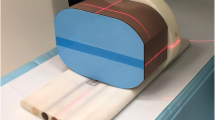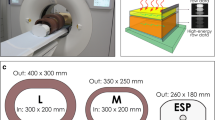Summary
Dual photon absorptiometry measurements of the spine are subject to drift associated with source, source strength, and truncal thickness. This study was conducted to determine the extent to which this drift in bone mineral density (BMD) measurements can be improved by analysis of scans with a new software version, 08C, and by applying external standard or phantom corrections to scans analyzed with the older version, 08B. A phantom, consisting of human lumbar vertebrae embedded in acrylic, and five clear acrylic plates to simulate a soft-tissue thickness range of 15.2–27.9 cm, was measured on a Lunar Radiation Corp DP3 scanner over the life of a 153-gadolinium (Gd) source and scans analyzed with software versions 08B and 08C. Phantom BMD was lower with 08C at both high [0.012±0.002 (SEM) g/cm2,P<0.001] and low (0.027±0.003 g/cm2,P<0.001) count rates than with 08B. Phantom BMD of scans analyzed with 08B increased with increasing source age and the source strength-related increment increased significantly as acrylic thickness increased (P=0.014). When the same scans were analyzed with 08C, the thickness-related effect was corrected whereas a small (0.011 g/cm2/year) source-strength effect persisted. The effects of source strength and truncal thickness on BMD were also evaluated in 40 humans scanned at two detector collimations to vary count rate. With 08B, mean BMD was 1% greater when measured with 8 than with 13 mm collimation (mean difference 0.011±0.003 g/cm2,P=0.001), whereas the version 08C, mean BMD was the same at the two collimations. Similarly, when phantom corrections were applied to the scans analyzed with 08B, the source strength effect was no longer significant. A truncal thickness effect, apparent in the 40 human scans analyzed with 08B, was not present with 08C. Finally, the phantom was scanned with three different Gd sources. With both 08B and 08C, BMD values were similar with two and significantly lower (by 0.012±0.002 g/cm2,P=0.011) with the third Gd source. Thus, with the new analysis software 08C, multiple thickness calibration is no longer needed, however, calibration with an external standard is still necessary.
Similar content being viewed by others
References
Leblanc AD, Evans HJ, Marsh C, Schneider V, Johnson PC, Jhingran SG (1986) Precision of dual photon absorptiometry measurements. J Nucl Med 27:1362–1365
Hanson JA, Mazess RB, Barden H (1986) Influence of source activity on dual-photon scans (abstract). J Bone Min Res 1:281
Lindsay R, Fey C, Haboubi A (1987) Dual photon absorptiometric measurements of bone mineral density increase with source life. Calcif Tissue Int 41:293–294
Ross PD, Wasnich RD, Vogel JM (1988) Precision error in dual-photon absorptiometry related to source age. Radiology 166:523–527
Shipp CC, Berger PS, Deehr MS, Dawson-Hughes B (1988) Precision of dual-photon absorptiometry. Calcif Tissue Int 42:287–292
Peppler WW, Mazess RB (1981) Total body bone mineral and lean body mass by dual-photon absorptiometry. I. Theory and measurement procedure. Calcif Tissue Int 33:353–359
Riggs BL, Wahner HW, Seeman E, Offord KP, Dunn WL, Mazess RB, Johnson KA, Melton LJ (1981) Changes in bone mineral density of the proximal femur and spine with aging. Differences between the postmenopausal and senile osteoporosis syndromes. J Clin Invest 70:716–723
Dawson-Hughes B, Jacques P, Shipp C (1987) Dietary calcium intake and bone loss from the spine in healthy postmenopausal women. Am J Clin Nutr 46:685–687
Nilas L, Hassager C, Christiansen C (1988) Long-term precision of dual photon absorptiometry in the lumbar spine in clinical settings. Bone Mineral 3:305–315
Witt RM, Appledorn CR, Wellman HN, Johnston CC (1986) Evaluation of gadolinium-153 sealed sources used in dual-photon bone mineral scanners (abstract). J Nucl Med 27:1067
Author information
Authors and Affiliations
Rights and permissions
About this article
Cite this article
Dawson-Hughes, B., Deehr, M.S., Berger, P.S. et al. Correction of the effects of source, source strength, and soft-tissue thickness on spine dual-photon absorptiometry measurements. Calcif Tissue Int 44, 251–257 (1989). https://doi.org/10.1007/BF02553759
Received:
Revised:
Issue Date:
DOI: https://doi.org/10.1007/BF02553759




